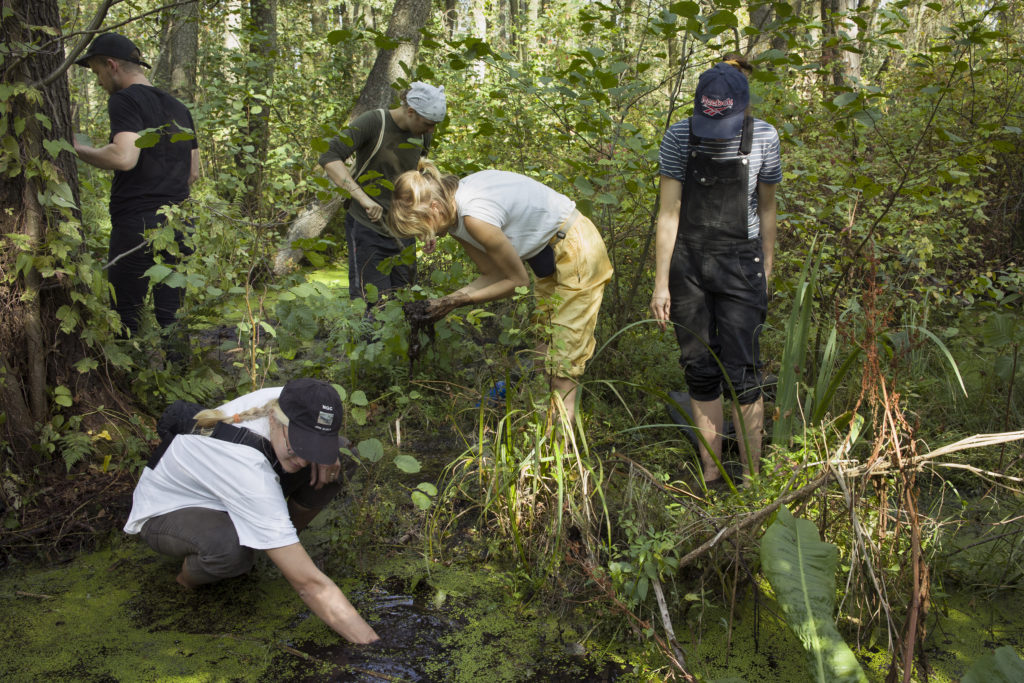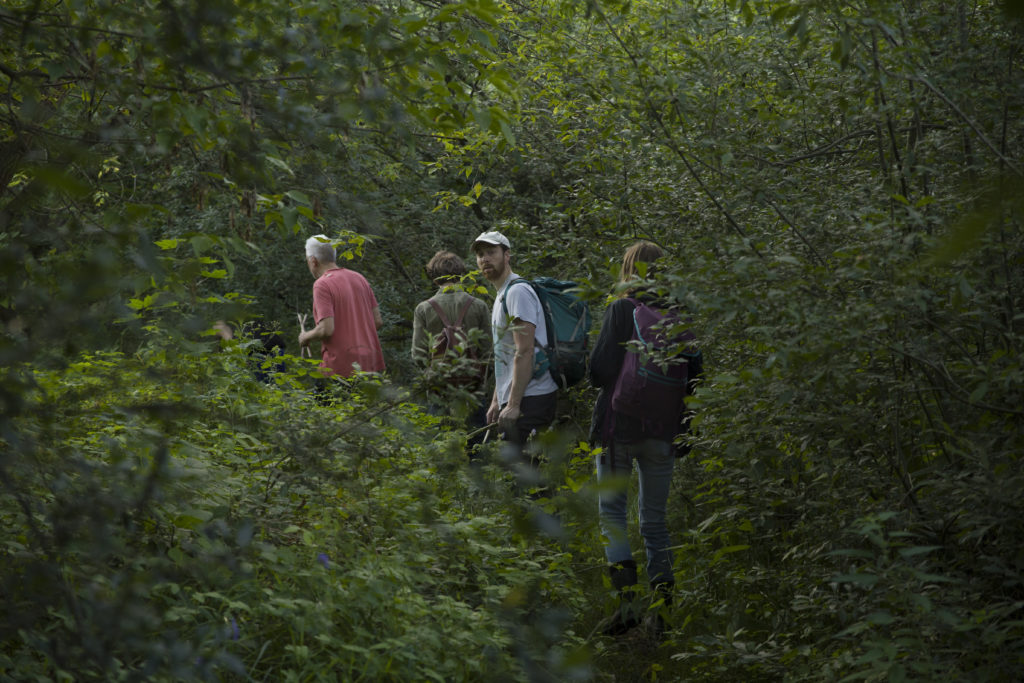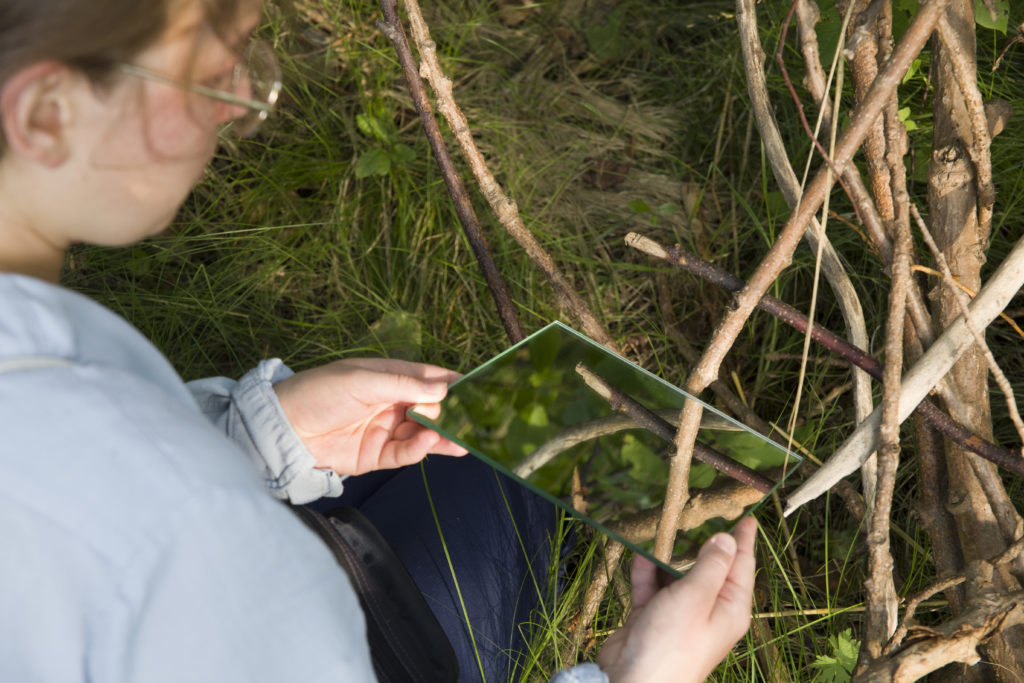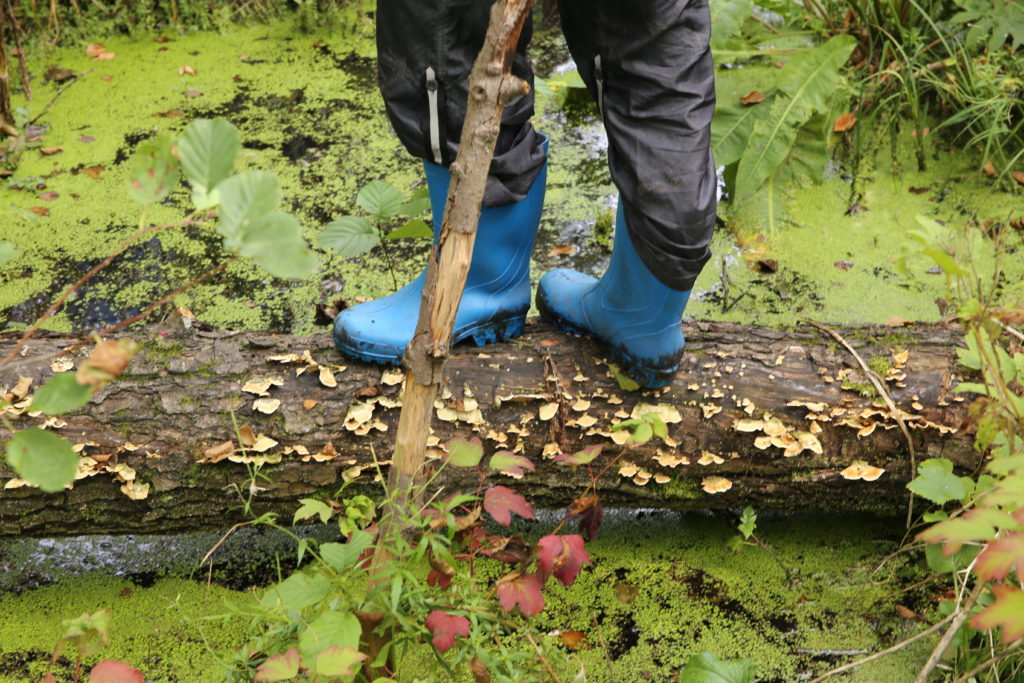SWAMP GATHERING

© Zakole Group
SWAMP GATHERING
Feel the ground beneath your feet, recognize your breathing, slowly move your ankles. Shake your body, let the city stress dissolve – we are entering the bog.
Walk carefully, moving slowly and attentively towards obstacles on your way. Observe anything that catches your eye. Focus on the sounds that come to you.
Rustling trees, wind softly rummaging in canes and sedges, birds, crickets and other unidentified vocal residents. The repetitive sound of steps on the muddy ground is interrupted by a sudden splash of a rubber boot in the water. It’s always the same place by two alders growing on the path – we forgot to give a warning, absorbed by the intensity of the bog.
Life in the alder carr, getting denser everyday now, seems just as busy as the stone’s throw-away urban whirl. Its constant roar is here to remind us that we are not within wilderness that spills freely over a vast area, but rather squished by a highly transformed landscape – a city pressing against it with all its busy streets, skyscrapers, housing estates, arranged parks and forgotten wastelands, all of which were wetlands at one point in time.
Zakole Wawerskie definitely was here before us. It is an oxbow backwater of the Vistula river, turned into a wetland complex cut off from the river with wet meadows and peat bogs overgrown with alder carr. Agriculture, prevalent in the area for some time – omnipresent drainage ditches still bear witness to that era – slowly withdrew over last decades, allowing Zakole to rewet and rewild.
When entering Zakole Wawerskie with others, we usually choose a route that allows us to introduce the place gradually. It is not uncommon to experience a bit of a shock after suddenly entering the wetland, traversing it at the same speed as the streets before. But Zakole has its own pace and rhythm. A visitor ought to figure out the pace of their visit, taking notice that, for this short time, it becomes its part just like any other being. But how do we attune to the wetland and its inhabitants? (ZD)
LISTENING
Pick a sound the closest to you, pick a sound which marks the border of what you can hear. In the distance in between, find one that is moving and follow it, observing its qualities. Pick a sound that is there but you cannot hear it, as it happens on frequencies unavailable to the ear. Pick a sound that is no longer, a silent reminder of extinction.

© Zakole Group
Zakole’s polyphonic soundscape happens in the clash, a loud, unexpected encounter.
The pulsating city humm envelops the area in circular motion. Although it never stops, a more immediate, closer, high-pitched note of birds announcing their return takes all the attention. A more constant cricket chirp synchronizes with the humm, making it feel distant, a mere background. As spring will fill plant tissues with water, the sound caused by touch will soften and all the breaking and rubbing that happens as a heavy body lies down on the grass is muted. Then, as soon as it makes itself comfortable lying down, the main act of the first spring evening starts, brought by a lazy mosquito; the ear immediately picks up on all the threats it will get from these creatures in the next months, cutting through the lower notes with their sharp, metallic buzz. (OR)
READING

© Zakole Group
Sometimes we need a bit of guidance, following a path that is dear to us but turning here and there to encounter something new. Reading in the tall reeds is as rustling as it sounds. We walk into the pale yellow clusters sometimes barefoot, sometimes in long sleeves to protect us from scratches of dry stalks, depending on how one prefers to interact with the space. We go a bit in, not that far, but far enough to feel completely surrounded by an endless field. After breaking through the dense matter we find a bit of peace in standing still or rocking gently from side to side, moving from foot to foot, similar to the reeds. It might get cozy, it might get claustrophobic. The text starts to roar with dry leaves, worlds become tangible as they enter the audio sphere of Zakole, we hear them for their meaning but also for their sound. They stick to the stalks or float in between, depending on their pronunciation and sense. Phrases acquire specific interpretation in the context of the place, frame it in a critical discourse, become intimate in this narrow reading room. We dream about making a little chamber in the reeds dedicated to this exercise. (PS)
BOG WALK
Surface plump with water gives a slightly delayed response to the weight of one’s step. You have to give it time to understand how deep the foot will go; sometimes walking quickly prevents sinking, sometimes it does not. A long stick serves as a useful tool in the peatbog game of balance, becoming also an extension of one’s body by sensing carefully the depth and structure of the unstable mass below the water surface. The pace of one’s movement determines the encounter. Once balance is achieved, taking one’s gumboots off allows for a walk-within-the-walk by making a single step into the peat’s deeptime.

© Zakole Group
First, the smell hits the nostrils with an irritating hint of sulfur and pleasantly-unpleasant notes of rot. Under the pressure of the step, the water surface starts bubbling up as some greenhouse gasses are getting out after spending millenia entrapped in the peat. The foot is at first confused as to what depth it sinks and on what exactly it is standing. Then, after a while, it starts recognizing structures and shapes, understanding that it is not a uniform mass but rather a composition of different elements. As the body recalibrates and arrives in a comfortable position, it remains overwhelmed with the amount of information gained by the eyes looking around and the feet feeling all the feels. Plants are blurring the borders between ‘water’ and ‘land,’ a distinction which truly doesn’t serve one that much in this environment. And while green dominates the eyes, plantbodies are present everywhere, making up the mass the feet are standing on. Remaining still not fully decomposed after thousands of years of being immersed in a low-oxygen watery condition, they are in a process so slow that by reaching with one’s hand in the peat, a reed leaf, sedge root or bogbean seed might mean an encounter with a thousand-year-old plant still keeping some of its material qualities. Now, having that sedge root in hand and stroking fresh sedge leaves growing from little island-clusters, the body connects not only to the same species, but quite likely, to the same specimen in its bits so old and so new. As the clouded water settles down, it becomes clear against all muddy thoughts about the bog. (OR)
DRY SOUND BATH
This is a story about water, which determines the rhythm of life of a bog. With its presence, the swamp becomes itself. Yet seasonal fluctuations of water are reflected in the bodies of plants, which dry up, crumble and rustle in autumn and winter.

© Zakole Group
This is a group exercise in which we swap roles. First, the first half listens and the second half looks for sounds. Then the other way around. For the former it is important to lie down comfortably – together find a soft place, somewhere in a meadow, where there are no ant nests and molehills, or on a branch of a fallen poplar, where the arrangement of branches and knots allows you to find comfort for your body. Then you need to lie down next to each other and close your eyes and listen. Relaxation of the body comes with time.
For the latter, the exercise begins with finding branches, leaves, bark, scales, needles, down and other dry plant parts. The touching and movement of these items is accompanied by sounds. Searching for rustles, crackles, and murmurs is intentional and attentive. Their recipients are the people in the other group. The sounds fluctuate in-between bodies and space, they are a soft and sensitive intervention in the peatbog’s audiosphere. Some of them are tender and nearly inaudible, others are crackling and harsh. (KJS)